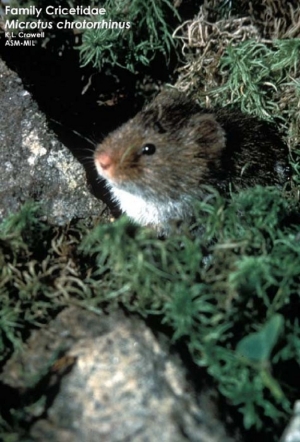Rock Vole, Microtus chrotorrhinus
This Rare vole, with a diagnostic yellow nose, is known only from the mountains of far eastern Tennessee.
Description:
A small, stocky rodent with short legs, large head, and small eyes. The nose is distinctly yellowish to orange and spreads back towards the moderately large ears. The back color is yellowish-brown and the belly is silvery-gray. Their tail is relatively long and it is slightly lighter below.
Length: 5.4 - 7.3 inches
Tail: 1.8 - 2.1 inches
Ears: 0.5 - 0.8 inches
Weight: 1.0 - 1.38 ounces
Similar Species:
Prairie, Woodland, and Southern Red-backed Voles, and Southern Bog Lemming all lack yellow noses.
Habitat:
Rock Voles occur in a specialized habitat of cool, moist talus slopes with mossy rocks and logs, in the mountains.
Diet:
Green vegetation, especially bunchberries, blueberries, mosses, grasses, ferns, and other plants, constitute most of their diet. They will also eat invertebrates and fungi.
Breeding information:
Breeding occurs between spring and late fall. Females produce 2-3 litters per year on average. The gestation period is believed to be 19-21 days and litter sizes range from 1-7 (average 3-4) young. Nests are not very well built, which is believed to result in low juvenile survival.
Status in Tennessee:
The Rock Vole is uncommon, and Deemed in Need of Management by TWRA and Tennessee Department or Environment and Conservation.
Fun Facts:
•Rock Voles are mostly diurnal, but they are still rarely seen.
•The Latin name Microtus means "small ears," which applies to all voles, and chrotorrhinus means "color and nose," which refers to their yellow noses.
Best places to see in Tennessee:
Forest openings in the Appalachian Mountains.
